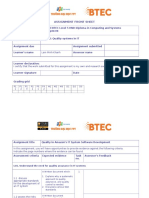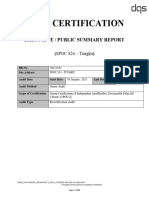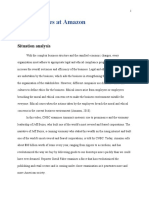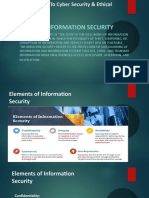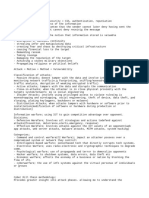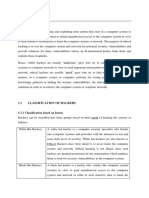0 ratings0% found this document useful (0 votes) 80 views35 pagesModul 1 - Ethical Hacking
Copyright
© © All Rights Reserved
We take content rights seriously. If you suspect this is your content,
claim it here.
Available Formats
Download as PDF or read online on Scribd
baa ms a ey
Bites Me asic,
Module 01
SHC ROC eee eh ted�Module Flow
° gertmeiae 8 etngcaer
Information Security
Laws and Standards�Elements of Information Security
Information security isa state of well-being of information and infrastructure in which the possibilty of theft, tampering,
and disruption of information and services is low or tolerable
|
Confidentiality Assurance that the information is acessible only to those authorized to have access
‘The trustworthiness of data or resources in terms of preventing improper or unauthorized changes
‘Assurance that the systems responsible for delivering, storing, and processing information are
accessible when required by the authorized users
Refers to the characteristic of a communication, document, or any data that ensures the quality of
being genuine
‘Aguarantee that the sender of a message cannot later deny having sent the message and that the
recipient cannot deny having received the message�Motives, Goals, and Objectives of Information Security Attacks CEH
Attacks = Motive (Goal) + Method + Vulnerability
{© A motive originates out of the notion that the target system stores or processes something valuable, and this
leads to the threat of an attack on the system
{Attackers try various tools and attack techniques to exploit vulnerabilities in a computer system or its security
policy and controls in order to fulfil their motives
Motives behind information security attacks
‘© Disrupting business continuity Propagating religious or political beliefs
°
‘© Stealing information and manipulating data © Achieving a state's military objectives,
© Creating fear and chaos by disrupting critical © Damaging the reputation of the target
infrastructures © Taking revenge
°
‘Causing financial loss to the target Demanding ransom�Classification of Attacks
Passive attacks do not tamper withthe data and involve intercepting and monitoring network traffic and
dataflow on the target network
Examples include sniffing and eavesdropping
Active attacks tamper withthe data in transit or disrupt the communication or services between the systems
‘0 bypass or break into secured systems
Examples include DoS, Mar-in-the-Middle, session hijacking, and SQL injection
Close-in attacks are performed when the attackers in close physial proximity with the target system or
network inorder to gather, modify or dlsrupt access to information
Examples include social engineering suchas eavesdropping, shoulder surfing, and dumpster diving
Insider attack involve using privileged access to violate rules or intentionally cause a threat tothe
organization’ information oF information systems
Examples include theft of physical devices and planting keyloggers, backdoors, and malware
Distribution attacks occur when attackers tamper with hardware or software prior to installation
[Attackers tamper withthe hardware or software atts source orn transit,�Information Warfare
{@ The term information warfare or InfoWar refers to the use of information and communication technologies (ICT)
to gain competitive advantages over an opponent
Defensive Information Warfare { Ottensive taformationWarare_}
Refers to all strategies and actions designed Refers to information warfare that involves
to defend against attacks on ICT assets attacks against the ICT assets of an opponent
ao
—
a
@ mam
oe
oe
=�Cyber Kill Chain Methodology
(© The cyber kil chain methodology is 2 component of intlligence-driven defense forthe identification and prevention of malicious
intrusion activities
1@ It provides greater insight into attack phases, which helps security professionals to understand the adversary's tactics, techniques,
and procedures beforehand
Create a deverable Expot a vloerbitty ‘Create a command and contol
malicious payload using by executing code on ‘channel to communieate 2nd
anevpiot anda backdoor the wt’ stem pass data back ana forth
Weaponization Exploitation Command and Control
a
Actions on Objectives
Gather ana on the target ‘Send weaponzes bund 0 the Insta maware on Perform ations eve
to probe for wesk points ‘tim using eral. USB, the target sytem mended objecves/enae�Tactics, Techniques, and Procedures (TTPs)
‘The term Tactic, Techniques, and Procedures (TTPs) refers tothe patterns of activities and methods associated
with specific threat actors or groups of threat actors
ae
(© “Tactics” are the guidelines that | “Techniques” are the technical \© "Procedures" are organizational
describe the way an attacker ‘methods used by an attacker approaches that threat actors
performs the attack from to achieve intermediate results follow to launch an attack
beginning to the end during the attack
{© The number of actions usually
This guideline consists of the Sihaco tcl ques indie differs depending on the
various tactis fr information soplatation eeting vn and objectives ofthe procedure and
gathering to perform initial enced threat ator group
exploitation, privilege escalation, ntl cheortits sccartha the
and lateral movement, and to target infrastructure, covering
deploy measures for persistent the tracks of data exftraton,
access to the system and other and others
purposes�Adversary Behavioral Identification CEH
{© Adversary behavioral identification involves the identification of the common methods or techniques followed
by an adversary to launch attacks on or to penetrate an organization's network
It gives the security professionals insight into upcoming threats and exploits
Adversary Behaviors
Internal Reconnaissance Bh vs otconmancuieitrace | | ve ot ons tunstig
| HTTP User Agent Use of Web Shell
UnspcedPrny Actes | | [J commandandonolserer | | [J] ostsiang�Indicators of Compromise (IoCs)
& Indicators of Compromise (IoCs) are the clues, artifacts, and pieces of forensic data found on the network
‘or operating system of an organization that indicate a potential intrusion or malicious activity in the
organization's infrastructure
1oCs are not intelligence, although they do act as a good source of information regarding the threats that
serve as data points in the intelligence process
Security professionals need to perform continuous monitoring of loCs to effectively and efficiently detect
‘and respond to evolving cyber threats�Categories of Indicators of Compromise
‘© Understanding loCs helps security professionals to quickly detect the threats against the organization and protect
the organization from evolving threats
For this purpose, loCs are divided into four categories:
Email Indicators Network Indicators Host-Based Indicators Behavioral Indicators
© Emallindicators are used © Networkindicators are © ‘Host-based indicators are Behavioral indicators of
tosend malicious data to useful for command and found by performing an compromise are used to
the target organization or | control, malware delivery, | analysis ofthe infected ‘identify specific behavior
individual Identifying the operating | system within the lated to malicious activities
system, and other tasks ‘organizational network
Examples include the 7 er Examples of behavioral
sender’s email address, Examples include URLs, Examplesinclude filenames, | indicators include document
email subject, and domain names, and IP file hashes, registry keys, ‘executing PowerShell script,
attachments or links addresses DLs, and mutex ‘and remote command
execution�Module Flow�What is Hacking?
|@ Hacking refers to exploiting system vulnerabilities and compromising security controls
to gain unauthorized or inappropriate access to a system's resources
© Itinvolves modifying system or application features to achieve a goal outside of the
creator's original purpose
1@ Hacking can be used to steal and redistribute intellectual property, leading to business ==
loss IW�Who is a Hacker?
01 02
‘An intelligent individual with For some hackers, hacking is a
excellent computer skills who hobby to see how many
can create and explore computers or networks they
computer software and can compromise
hardware
rily
Jaa oo
CEH
03
‘Some hackers’ intentions can
either be to gain knowledge
(r to probe and do illegal
things
‘Some hack with malicious intent such as to steal business data, credit card information, social security numbers,
‘email passwords, and other sensitive data�Hacker Classes
CEH
@ @Q
Black Hats White Hats
Individuals with extraordinary Individuals who use their
computing sks they resort to professed hacking skis for
malisous or destructive ‘efensive purposes and ae also
acts and ae also known known as security analysts
secrackers They have permision from the
system owner
eG eo
Script Kiddies CyberTerrorists
‘An unskled hacker who Individuals with wide range of
compromises a system by skills who are motivated by
running Script, t00s, nd religous or poltial beliefs to
software that were developed create fear through the large-
Dy real hackers Scale diseupton of computer
networks
@Q
Gray Hats
Individuals who work both
‘offensively and defensively at
various times
oQ
State-Sponsored Hackers
Individuals employed by the
government to penetrate and
{ain top secret information
{rom and do damage tothe
information systems of other
governments
Suicide Hackers
Inaivcuals who aim to bring
‘down the rtial infrastructure
for “ause” and are not
worried about facing al terms
‘or any othe kindof punishment
Hacktivist
Individuals who promote 2
political agenda by hacking,
especially by defacing or
disabling websites�Hacking Phase: Reconnaissance
‘© Reconnaissance refers to the preparatory phase where an attacker seeks to gather information about a target prior to
launching an attack
| This information could be the future point of return, noted for ease of entry for an attack, when more about the target is
known on a broad scale
‘@ The reconnaissance target range may include the target organization's clients, employees, operations, network, and systems
Reconnaissance Types
Passive Reconnaissance Active Reconnaissance
© Passive reconnaissance involves acquiring © Active reconnaissance involves directly
information without directly interacting interacting with the target by any means
with the target
© For example, telephone calls to the target's
© For example, searching public records or help desk or technical department
news releases�Hacking Phase: Scanning
Scanning refers to the pre-attack phase when the attacker scans the
network for specific information based on information gathered during
reconnaissance
Scanning can include the use of dialers, port scanners, network mappers,
ping tools, and vulnerability scanners
Attackers extract information such as live machines, port, port status,
OS details, device type, and system uptime to launch attack�Hacking Phase: Gaining Access ¢
Gaining access refers to the point where the The attacker can escalate privileges to obtain
Bp tees tae se cents complete control of the system. In this process,
or applications on the target computer or BA the target's connected intermediate systems
network are also compromised
a |
Examples include password cracking, buffer
overflows, denial of service, and session
hijacking
—EeE———————e OE
By The attacker can gain access at the operating mn
£4 system, application, or network levels Li�Hacking Phase: Maintaining Access CEH
Maintaining access refers to the phase when the attacker tries to retain their ownership
of the system
‘Attackers may prevent the system from being owned by other attackers by securing their
exclusive access with backdoors, rootkits, or trojans,
Attackers can upload, download, or manipulate data, applications, and configurations on
the owned system
‘Attackers use the compromised system to launch further attacks�Hacking Phase:
Clearing Tracks
Clearing tracks refers to the
activities carried out by an
attacker to hide malicious acts
&
‘The attacker's intentions include
‘obtaining continuing access to
the victim's system, remaining
unnoticed and uncaught, and
deleting evidence that might
lead to their prosecution
The attacker overwrites the
server, system, and application
logs to avoid suspicion
&
Attackers always cover their tracks to hide their identity�Module Flow
@ information security @ qeerninichata
Overview Concepts
@ _ Information Security @ _tsermation Security
LEQ ey�What is Ethical Hacking?
{© Ethical hacking involves the use of hacking tools, tricks, and techniques to identify vulnerabilities
‘and ensure system security
© It focuses on simulating the techniques used by attackers to verify the existence of exploitable
‘vulnerabilities in a system's security
| Ethical hackers perform security assessments for an organization with the permission of
concerned authorities�Why Ethical Hacking is Necessary
To beat a hacker, you need to think like one!
Ethical hacking is necessary as it allows for counter attacks against malicious hackers through anticipating the
methods used to break into the system
Reasons why organizations recruit ethical hackers
‘To prevent hackers from gaining access to the To provide adequate preventive measures in order to
‘organization’ information ystems avoid security breaches
‘To help safeguard customer data
‘To uncover vulnerabilities in systems and explore their
potential as a security risk
posture, including policies, network protection
infrastructure, and end-user practices
‘To enhance security awareness at all levels in a business
‘To analyze and strengthen an organization's security |�Why Ethical Hacking is Necessary (Cont'd)
Ethical Hackers Try to Answer the Following Questions
What can an intruder see on the target system? (Reconnaissance and Scanning phases)
‘What can an intruder do with that information? (Gaining Access and Maintaining Access phases)
Does anyone at the target organization notice the intruders’ attempts or successes? (Reconnaissance and
Covering Tracks phases)
Are all components of the information system adequately protected, updated, and patched?
How much time, effort, and money are required to obtain adequate protection?
‘Are the information security measures in compliance with legal and industry standards?�Scope and Limitations of Ethical Hacking CEH
Scope
‘© Ethical hacking is a crucial component of risk
assessment, auditing, counter fraud, and
information systems security best practices
Itis used to identify risks and highlight remedial
actions. It also reduces ICT costs by resolving
vulnerabilities
Limitations
@ Unless the businesses already know what they
are looking for and why they are hiring an
‘outside vendor to hack systems in the first
place, chances are there would not be much
to gain from the experience
‘An ethical hacker can only help the organization
to better understand its security system; itis up
to the organization to place the right safeguards
on the network
Clete)�Skills of an Ethical Hacker
Technical Skills
{In-depth knowledge of major operating environments
such as Windows, Unix, Linux, and Macintosh
In-depth knowledge of networking concepts,
technologies, and related hardware and software
‘Acomputer expert adept at technical domains
Knowledgeable about security areas and related issues
“High technical” knowledge for launching sophisticated
attacks
2 Non-Technical Skills
© The ability to learn and adopt new technologies quickly
© Strong work ethics and good problem solving and
communication skills
@ Committed to the organization's security policies
© An awareness of local standards and laws�Module Flow
e © tecring Concepts
© _ nfermation security
Laws and Standards
am�Information Assurance (IA) c\EH
© lArefers to the assurance that the integrity, availability, confidentiality, and authenticity of information and information
systems is protected during the usage, processing, storage, and transmission of information
{© Some of the processes that hep in achieving information sssurance include
Developing local policy, process, and guidance @ cresting pins or identi resource requirements
Designing network and user authentication strategies | @)_ Applying appropriate normaton assurance controls
‘dentitying network vulnerabilities and threats Performing certification and accreditation
|dentitying problem and resource requirements Providing information assurance t�Defense-in-Depth
© Defense-in-depth is a security strategy
in which several protection layers are
placed throughout an information
system
Ithelps to prevent direct attacks against.
the system and its data because
a break in one layer only leads the
attacker to the next layer
at
Defense-in-Depth Layers
Defense-in-Depth Layers�What is Risk?
\@ Risk refers to the degree of uncertainty or expectation that an adverse event may cause damage to the system
1G Risks are categorized into different levels according to their estimated impact on the system
(@ Arisk matrixis used to scale risk by considering the probability likelihood, and consequence or impact of the risk
Nery Hh
rovality
eh
reas
No uren scons equtes a
melee contro 80m 3 pose rotaity
tovetice it to reason ow tel =
=_ low Mesum Medium Hah
Tate revere eps to mia the oz
ties ea tow tow Mesum Meum Hah�Risk Management CEH
{© Risk management is the process of reducing and maintaining risk at an acceptable level by means of a well-defined
and actively employed security program
Risk Management Phases
Risk Identification © '“tfies the sources, causes, consequences, and other details of the internal and external
risks affecting the security of the organization
‘Assesses the organization's risk and provides an estimate of the likelihood and impact,
Risk Assessment eee
Risk Treatment Selects and implements appropriate controls forthe identified risks
Ensures appropriate controls are implemented to handle known risks and calculates,
Risk Tracking the chances ofa new risk occurring
Risk Review Evaluates the performance of the implemented risk management strategies�Cyber Threat Intelligence
‘Types of Threat Intelligence
?
‘© Cyber Threat intelligence (CT) is defined as Strategic Tactical
the collection and analysis of information
about threats and adversaries and the
drawing of patterns that provide the ability
to make knowledgeable decisions for
preparedness, prevention, and response
actions against various cyber-attacks \
© Hightevel information on Information on attacker
changing sks Tes
© Consumed by high-level ‘Consumed by Service
Executives and ‘and SOC Managers,
‘Management ‘Administrators
Longeterm Use
Operational ( ‘Technical
© Information on a spectc Infomation on spec
incoming tack indoors of compromise
© Consumed by Security Consumed by SOC Stat
Managers and Netwerk andi oars
Detenders
Cyber threat intelligence helps the organization
to identify and mitigate various business risks
by converting unknown threats into known
threats; it helps in implementing various
‘advanced and proactive defense strategies
term/immediate Use�Threat Modeling CEH
‘Threat modeling is a risk assessment approach for analyzing the security of an application by capturing, organizing,
and analyzing all the information that affects the security of an application
Threat Modeling Process
Helps to determine how much effort needs to be put toward subsequent steps.
Identify the components, data flows, and trust boundaries
Helps to find more relevant and more detailed threats
Identify threats relevant to the control scenario and context using the information
obtained in steps 2 and 3
Identity weaknesses related to the threats found using vulnerability categories�Incident Management CEH
© Incident management isa set of defined processes to identify, analyze, prioritize, and resolve security incidents
to restore normal service operations as quickly as possible and prevent future recurrence of the incident
Incident Management
Incident Handling�Incident Handling and Response
‘© Incident handling and response (IH&R) is the process of taking organized and careful steps when reacting toa
security incident or cyberattack
Steps involved in the TH&R process:
|e Preparation
i) Incident Recording and Assignment
le Incident Triage
|e Notification
| © containment
| @ Evidence Gathering and Forensic Analysis
@ Exadication
© Recovery
© Post-incident Activities
© Incdent Documentation
1 Incident impact Assessment
Review and Revise Policies
Close the investigation
Incident Disclosure

